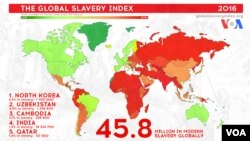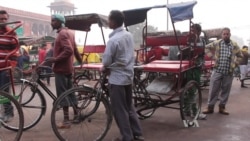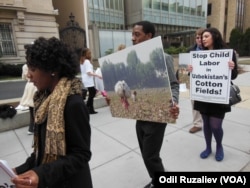An Australian group tracking modern-day slavery says countries doing the least to fight the practice affecting some 45 million people worldwide often have slavery-complicit governments, as well as high levels of conflict and political instability.
Among the countries it singles out in the Global Slavery Index as taking the least action to combat slavery are North Korea, Iran, Eritrea, Central African Republic, Democratic Republic of Congo and South Sudan. Slavery conditions can include forced labor, including forced labor in prisons; commercial sexual exploitation; and forced marriage for women.
The Walk Free Foundation behind the study says North Korea has the highest percentage of its population enslaved. Nearly one in 20 people, or 4.37 percent of its population, are in servitude. India has the highest number of people living in slavery conditions at 18.35 million, followed by China with 3.39 million and Pakistan with 2.13 million.
Those numbers are up 10 million since the group's first survey in 2014.
Clothing industry
Many of those enslaved are working under forced labor conditions to make clothing that is exported globally, says Walk Free's executive director Fiona David, adding that consumers who buy those products may be contributing to the problem.
David told VOA: "The surveys in Bangladesh showed an estimated 1.5 million people being held in some form of forced labor. And, of course, Bangladesh is our largest source of ready-made clothing for consumers around the world. So this really has implications for everyday people in terms of what clothing they buy and sell. The same can be said for Cambodia."
Even the making of cheap fabric can contribute to global slavery numbers. Uzbekistan, for instance, subjects its citizens to forced labor in its annual cotton harvest. That fact has particular resonance in the United States, where African slaves two centuries ago were forced to labor in cotton fields in the American South, before such slavery was outlawed.
Human Rights Watch spokesman Wolfgang Buetner spoke to the Associated Press on the issue Tuesday.
"The textile industry presents a big problem with regard to forced labor, because very often the textile workers have to suffer very long working hours, are paid badly and often can barely leave the factories," he said.
"This is a problem in Bangladesh, where a lot of textile workers are working, but also in India and other countries in Southeast Asia. What is important is that the companies also live up to their responsibilities and that they check on [whether] the subcontractors comply with labor law standards."
Choosing slavery-free products
Walk Free has collected surveys in several wealthy countries where consumers can buy imported clothing made under forced-labor conditions. In 2016, 66 percent of U.S. consumers said they would stop buying a product if they were aware that its manufacture involved use of slave labor. Fifty percent said they would pay more for clothing, electronics, food, tea or coffee that was made under slavery-free conditions.
In 2015, Walk Free reported that 78 percent of Brazilians and 54 percent of Indians would switch brands if they found that the products they were using involved slave labor.
Also in 2015, Britain's parliament passed a law known as the Modern Slavery Bill, updating its anti-slavery law to include provisions that defend slavery victims against prosecution for crimes committed while they were enslaved. It also ensures that child victims have an advocate to support and care for them.
Walk Free estimates that there are as many as 13,000 victims of modern slavery in the United Kingdom, which includes England, Wales, Scotland and Northern Ireland.
Wealthier countries generally had lower slavery rates — the top 12 countries with the lowest rates of slavery are Western European, the U.S. and Canada, and Australia and New Zealand.
The study said Qatar, Singapore, Kuwait, Brunei, Hong Kong, Saudi Arabia, Bahrain, Oman, Japan and South Korea are among the nations whose governments have taken relatively little action against modern slavery despite adequate wealth and stability.
One hundred and sixty-seven countries were included in the study. Ratings for Afghanistan, Iraq, Libya, Somalia, Syria and Yemen were not included due to ongoing conflicts.
The study assessed factors such as "protection and respect for rights, physical safety and security, access to the necessities of life such as food, water and health care, and patterns of migration, displacement and conflict" to reach their conclusions.












